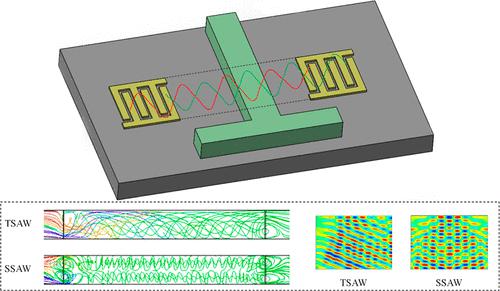当前位置:
X-MOL 学术
›
Ind. Eng. Chem. Res.
›
论文详情
Our official English website, www.x-mol.net, welcomes your
feedback! (Note: you will need to create a separate account there.)
Novel Study on the Mixing Mechanism of Active Micromixers Based on Surface Acoustic Waves
Industrial & Engineering Chemistry Research ( IF 3.8 ) Pub Date : 2022-06-16 , DOI: 10.1021/acs.iecr.2c01539 Honglin Lv 1 , Xueye Chen 1
Industrial & Engineering Chemistry Research ( IF 3.8 ) Pub Date : 2022-06-16 , DOI: 10.1021/acs.iecr.2c01539 Honglin Lv 1 , Xueye Chen 1
Affiliation

|
The method of using a surface acoustic wave (SAW) to drive fluid mixing on a microfluidic chip has been widely investigated by researchers because of its advantages of not directly contacting the fluid and not changing the chemical properties of the fluid. In this paper, we investigate the potential mechanism of SAW-driven fluid mixing. A SAW device is designed by us and modal and harmonic response analyses are performed on it. Because the mechanisms of the traveling SAW (TSAW) and the standing SAW (SSAW) on a fluid are different, we have performed transient simulations for each of them in order to clearly understand their differences. The effect of voltage values on the intensity of acoustic pressure is also studied by us. Finally, we perform a comprehensive analysis of acoustic-fluid force-driven fluid mixing. For TSAW- and SSAW-driven fluid mixing, we discuss and analyze the mixing effect at different voltages separately. The velocity fields of the two types of SAW-driven micromixers are also investigated. It is found that the mixing effect of both micromixers is enhanced with increasing voltage. However, the TSAW-driven micromixer produces a single vortex flow through the channel in the acoustic action region, while the SSAW-driven micromixer produces a symmetric double vortex flow. The difference between the TSAW- and SSAW-driven fluids can be clearly analyzed by the velocity field results. The TSAW drives the fluid mainly on one side of the microchannel, while the SSAW drives the fluid by superposition of the acoustic flow force on both sides of the microchannel. The results of this study contribute to a better understanding of the SAW-driven effect on the flow properties of fluids. Moreover, this work lays a theoretical foundation for practical applications in areas such as biochemical reactions and polymer synthesis.
中文翻译:

基于声表面波的有源微混合器混合机制的新研究
利用表面声波(SAW)在微流控芯片上驱动流体混合的方法因其不直接接触流体、不改变流体化学性质的优点而受到研究人员的广泛研究。在本文中,我们研究了 SAW 驱动的流体混合的潜在机制。我们设计了一个 SAW 设备,并对其进行了模态和谐波响应分析。由于流体上的移动 SAW (TSAW) 和站立 SAW (SSAW) 的机制不同,我们对它们中的每一个都进行了瞬态模拟,以便清楚地了解它们的差异。我们还研究了电压值对声压强度的影响。最后,我们对声-流体力驱动的流体混合进行了综合分析。对于 TSAW 和 SSAW 驱动的流体混合,我们分别讨论和分析不同电压下的混合效果。还研究了两种 SAW 驱动的微混合器的速度场。发现两种微混合器的混合效果随着电压的增加而增强。然而,TSAW 驱动的微混合器通过声学作用区域的通道产生单涡流,而 SSAW 驱动的微混合器产生对称的双涡流。通过速度场结果可以清楚地分析 TSAW 和 SSAW 驱动流体之间的差异。TSAW主要在微通道的一侧驱动流体,而SSAW通过微通道两侧的声流力叠加来驱动流体。本研究的结果有助于更好地理解 SAW 驱动对流体流动特性的影响。此外,这项工作为生物化学反应和聚合物合成等领域的实际应用奠定了理论基础。
更新日期:2022-06-16
中文翻译:

基于声表面波的有源微混合器混合机制的新研究
利用表面声波(SAW)在微流控芯片上驱动流体混合的方法因其不直接接触流体、不改变流体化学性质的优点而受到研究人员的广泛研究。在本文中,我们研究了 SAW 驱动的流体混合的潜在机制。我们设计了一个 SAW 设备,并对其进行了模态和谐波响应分析。由于流体上的移动 SAW (TSAW) 和站立 SAW (SSAW) 的机制不同,我们对它们中的每一个都进行了瞬态模拟,以便清楚地了解它们的差异。我们还研究了电压值对声压强度的影响。最后,我们对声-流体力驱动的流体混合进行了综合分析。对于 TSAW 和 SSAW 驱动的流体混合,我们分别讨论和分析不同电压下的混合效果。还研究了两种 SAW 驱动的微混合器的速度场。发现两种微混合器的混合效果随着电压的增加而增强。然而,TSAW 驱动的微混合器通过声学作用区域的通道产生单涡流,而 SSAW 驱动的微混合器产生对称的双涡流。通过速度场结果可以清楚地分析 TSAW 和 SSAW 驱动流体之间的差异。TSAW主要在微通道的一侧驱动流体,而SSAW通过微通道两侧的声流力叠加来驱动流体。本研究的结果有助于更好地理解 SAW 驱动对流体流动特性的影响。此外,这项工作为生物化学反应和聚合物合成等领域的实际应用奠定了理论基础。











































 京公网安备 11010802027423号
京公网安备 11010802027423号